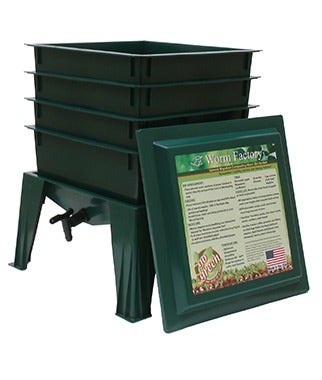We use cookies to give you the best experience on our website. These cookies are completely safe and secure and will never contain any sensitive information. Please read our Privacy Policy. By clicking "Ok" or clicking on any other content, you agree that cookies can be placed.
Getting Going With Worms
If the wiggly, slimy image of worms is the only thing keeping you from composting with these garden powerhouses, think again. Worms are nice housemates. Give them a simple bin, paper, and table scraps, and they’ll thank you with gifts of poo that you and your garden will love.
We‘re familiar with the basics of caring for a dog or cat. Those pets need shelter, exercise, nourishment and a place to use the bathroom. You use food bowls, leashes, and litter boxes.
But when welcoming worm pals into your home, ehh…. we don’t really have a clue.
Garden author Sharon Lovejoy says not to worry. Caring for your composting worms is not so complicated. It’s nature doing nature’s work. Give your worms a cool and damp environment and they will thrive.
Worms are beneficial pets. Their castings supercharge soil. Castings, created by the breakdown of organic material, are crazy nutrient rich. Beyond adding nutrients that your plants utilize as fertilizer, worm compost is full of life – beneficial microorganisms - that your soil can use to create more plant food. Worm composting is inexpensive and requires less maintenance than a compost pile since no turning is required.
All composting helps to reduce the amount of trash sent to the landfill while reducing the need to buy fertilizer. Gardeners with small spaces can find a place for a worm bin when a compost pile is not an option.
Lovejoy says worms are a great way to interest children in composting and nature. Kids love worm watching and handling. Loop them in to help with feeding and separating the worms from the compost.
All worms are not created equal – for composting. Like choosing the right type of dog to bring home to your family, you’ll want the right worm. Don’t take in strays. Worms dug up from your garden won’t survive in a worm bin.
Hands down, the best worm for composting is the red wiggler or Eisenia fetida. Red wigglers can eat! And they’re happy homebodies. They thrive in bins; contentedly making worm babies while turning your trash into rich nutrient filled compost. Worms can be ordered from several websites.
Worm composting is simple says Lovejoy.
“They eat. They poop. They eat. They poop. And then they reproduce,” she said.
Before inviting them to stay, you’ll need a snug home for your worms. They dig plastic or wood domiciles. And instead of granite countertops, house shopping worms, make good drainage a top priority. In fact, any commercially available worm bin or homemade bin with good drainage, will make worms happy campers as long as their bedding is shallow and moist not wet, and they’re not overfed.
Once you have a bin and worms, set-up housekeeping.
When your worms first arrive, make sure their packing material is still slightly moist. To prepare their bed, lay several layers of newspaper or cardboard at the bottom of the bin. Lightly wet the paper. Add crumpled-up shredded paper – including junk mail that isn’t glossy – to about half the area of your bin. Spray the paper with water to make it moist but not saturated. Keep it fluffy so your worms have enough air.
Under a bright light, gently spill your worms into the bedding. Worms like the night life and will bury down into the bedding to avoid light. Once they’ve moved in, sprinkle the bedding with a small amount of soil or dried leaves. This helps them break down waste.
The move will stress your worms. Wait several days before giving them any food.
Worms will eat most anything. Scraps of vegetables and fruit, cereals and starches, eggshells and coffee grounds are particularly good worm food. Avoid meat and dairy products as well as very acidic food.
The biggest mistake made is overfeeding worms. Drainage and air circulation will keep the compost fresh smelling and not sour. In this scenario, the compost is working aerobically. Too much food and water can cause compaction and create anaerobic break down of food, which can make your worms sick.
Lovejoy says to guard against too much liquid by keeping dry cardboard or newspaper on top of the worms under the lid. This will help absorb extra moisture.
Worms can take a little neglect and continue creating life-giving gifts for your garden.
“What could be a better pet?” ask Lovejoy, “ You don’t even have to walk them.”

